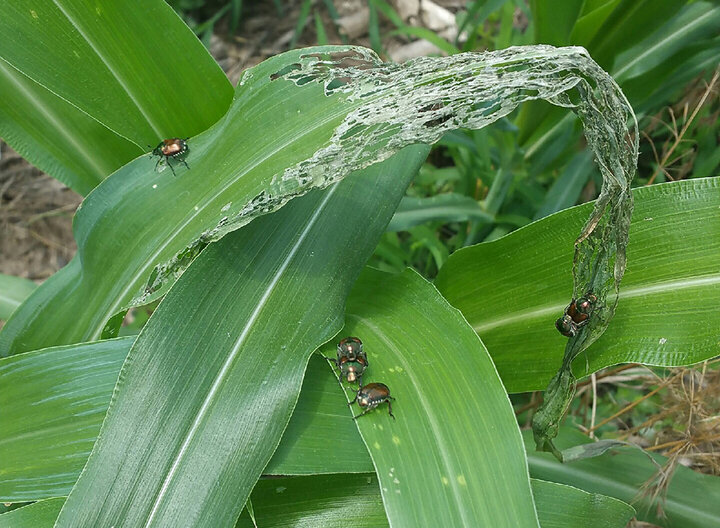Insects are a part of our environment. Most are beneficial, not problematic. In fact, only a small percentage — less than one percent of all insects — are considered pests. However, some pests can be very problematic because they are invasive insects that came here from another country and they came here without their natural predators. One such insect is the Japanese beetle (Popillia japonica Newman).

Japanese Beetles in Crops
Japanese beetle numbers have been increasing in Nebraska crops over the last five years and can be found in corn and soybeans in June and July.
The beetles will cause defoliation in both crops, but in corn, prefer silks when they're available. If abundant enough, this silk feeding can affect pollination.
For more information about Japanese beetles in Nebraska corn and soybean and thresholds for treatment, see this CropWatch article, Japanese Beetles Emerging; Identification Key to Management.
Japanese beetles came from Japan, where it is not a major pest due to the natural predators found there. This pest was first found in the United States in a New Jersey nursery in 1916 and was likely introduced in infested iris bulbs from Japan. Since this initial introduction, Japanese beetle populations have steadily expanded westward. As of January of 2015, Japanese beetle has been found in 34 states in the United States.
Why is it a problem?
Japanese beetles are problematic insects as both larvae and adults. The larvae are one of the four most common types of white grubs found in Nebraska. As a white grub, larvae feed on the roots of turfgrass, causing large brown dead spots in the turf that are easily lifted up like a rug from the floor.
As adults, Japanese beetles feed on over 300 species of plants including trees, shrubs, fruits, vegetables, field crops, weeds, and other ornamental plant species. Some of their favorite food plants are roses, lindens, and grapes. Adult beetles feed on the foliage, flowers, and fruits of these plants. They feed on the upper surface of the leaves and cause a skeletonized pattern to the leaf, often chewing away the rest of the leaf but leaving the veins. In some cases, they will consume the entire leaf. This can stress the plants and, with high beetle populations, even kill the plant.
Identification
Adult Japanese beetles are 7/16 inch long, metallic green beetles. The elytra, or wing coverings, are copper. These beetles can be distinguished from similar looking beetles by the six tufts of white hair along both sides of the abdomen.
Larvae of Japanese beetles look like other white grubs. They are C-shaped and creamy white. You can differentiate between species by looking at the pattern of hairs on the end of their abdomen. On a Japanese beetle grub, there is a V-shaped pattern in these hairs that can be seen under magnification.
What can we do about Japanese beetles in lawns?
Japanese beetles can be controlled through multiple methods. Larvae in lawns are best controlled with insecticides applied in May, June, or July. Among the many options are products containing chlorantraniliprole, imidacloprid, or clothianidin. Be sure to always read and follow the pesticide label before using any pesticide. Chlorantraniliprole products are the least harmful to pollinators in the environment.
There is also a biological control product that contains milky spore, a bacterium that causes a disease in the larvae to kill them, but not harm other organisms. However, this is not very effective at controlling the larvae and it occurs naturally so there is no need to purchase it as a pesticide.
In low adult populations, you can hand pick the beetles off of plants and throw them into a bucket of soapy water to kill them and not harm any pollinators. Pesticides can be used on the adults in plants, however, be sure to avoid use of pesticides directly on the flowers of these plants to avoid harming pollinators. Imidacloprid and chlorantraniliprole can be used on trees and shrubs to control the beetles. There are also traps available that are sold to control Japanese Beetle adults, however these traps often attract more beetles than they can capture and are typically not recommended for control.

